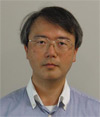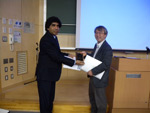|
Prof. Yukihiro Takahashi |
| |
 |
Prof. Yukihiro Takahashi participated in the
33rd Japanese Antarctic Research Expedition
in 1991-1993 as a member of wintering party
to observe auroral phenomena with newly
developed high-sensitivity camera, and based
on those data obtained there, he conducted
analysis and received his PhD degree in
Geophysics at Tohoku University in 1997 for
the study on the dynamics of proton aurora.
After coming back from Antarctica he was
involved in the transient luminous events (TLE)
studies, and joined the sprite observation
campaign in Colorado for several years. He
discovered elves with high-speed photometers
in 1995 and winter sprites in Japan in 1998
for the first time. He also contributes to
ISUAL onboard FORMOSAT-2, the 2nd Taiwanese
satellite, as a project manager of array
photometer (AP), which has been dedicated to
TLE observation from space for more than 10
years. He was project leader of the
micro-satellite RISING that was designed to
measure TLEs and launched in 2009. He is now
contributing to 3 micro-satellite projects,
namely, RISING-2 (launched in 2014), RISESAT
and UNIFORM-1(launched in 2014), as a
principal investigator of science missions.
He also developed AVON (Asian VLF
observation network) and GEON (global ELF
observation network) with colleagues in
Hokkaido and other university members, as a
leader or co-leader of those projects in
order to geolocate lightning strokes in Asia
and over the world, respectively.
Other than the Earth’s lightning phenomena,
he has been interested in planetary
atmosphere and constructed LAC (lightning
and airglow camera) onboard Akastuki
spacecraft (Venus orbiter) as principal
investigator and ground-based 1.6-m
telescope dedicated to planetary science as
leader. |
|
|
|
|
|
Program |
 |
|
|
|
 |
|


